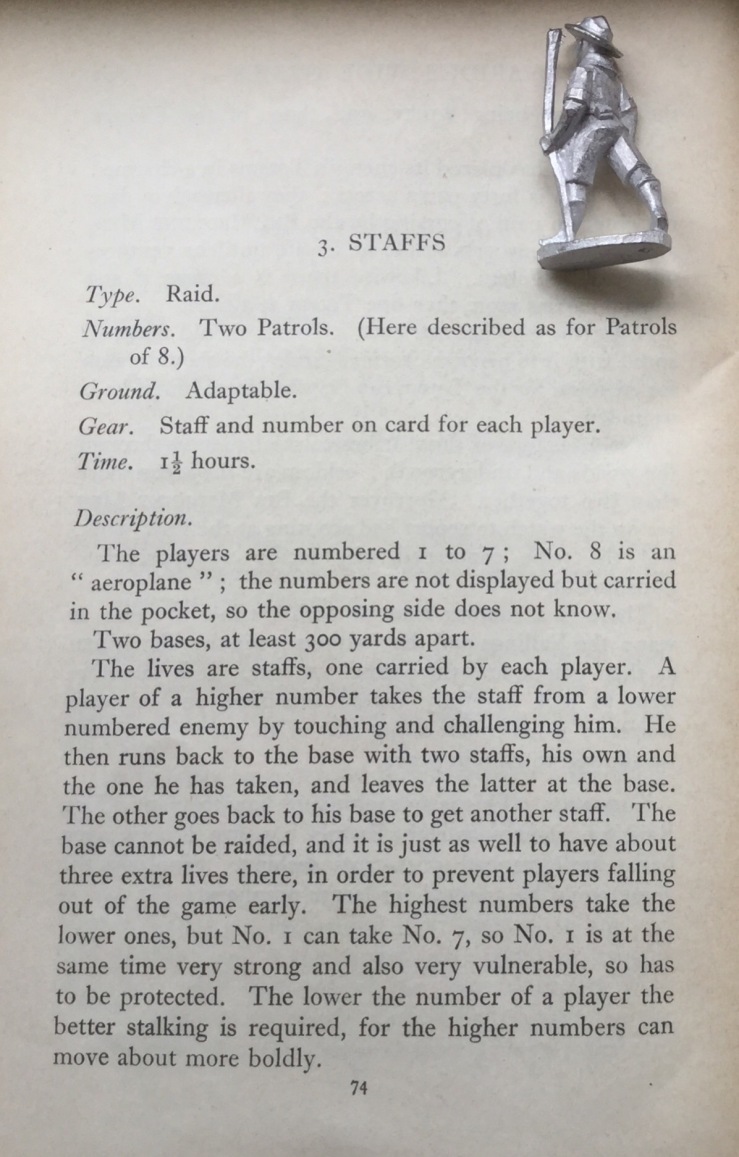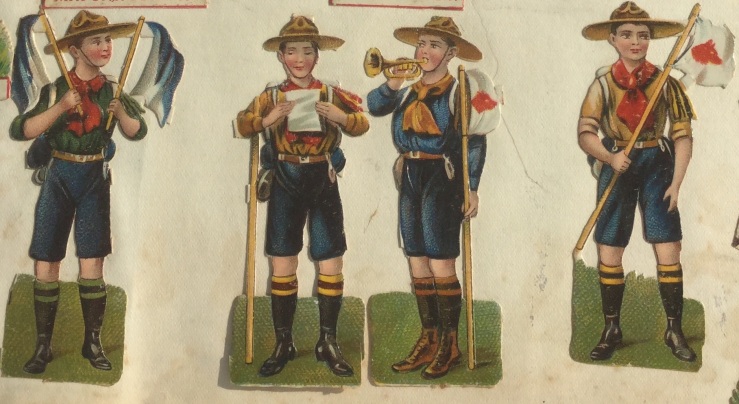
I am happily surprised by the many comments about memories of Scouting type Wide Games after my last blogpost https://manoftinblog.wordpress.com/2019/04/27/easter-eggs-wide-games-and-the-cloak-of-romance/
Alan Gruber, the Duke of Tradgardland https://tradgardland.blogspot.com has received his copy of Wide Games (Scout Association, 1933) and his reactions and initial thoughts were surprisingly similar to mine:
“The Wide Game book arrived and l have had a chance to have an initial look. There seems to be much that can be translated into rule terms. I am less successfully tried to locate my scout figures, they must be experts in stealth and use of cover.
I have been thinking of giving each scout ratings for things like stealth, speed, detection etc.
When trying to spot a hiding scout figure compare the hiding rating against the spotting rating adding the score of a dice. If the the result is higher than the hiding rating the figure is spotted.
I felt this method could be used also to represent the removal of a “wool life” .
I like the idea of each scout being different in his abilities adding a sort of role play vibe. I really must scribble these ideas down in a more coherent manner.”
Alan’s ideas were in tune with many of my own initial thoughts.
I also thought that the list of a scout’s skills looked like a character card or RPG character.
Badges acquired or skill numbers would help resolve some non-combat issues on points – visibility (stalking, camo, use of cover), listening skills, pathfinding etc.

Wide Games no. 3 – Staffs – has a hidden numbering system, 1 to 8 being allocated to each patrol and concealed from the enemy (maybe on their base). The number was only revealed when challenged – sometimes finding out that you have challenged a higher number too late, if you are low numbered! This solves the taking of the wool life, based on whether Scout is higher or lower.

Interestingly in Scouting for Boys (1908), BP suggests Patrols have regular numbers: Patrol Leader 1 with whistle, Corporal 2, scouts 3 and 4, scouts 5 and 6, scouts 7 and 8 working in pairs. No mention of the bugler!
As mentioned in Staffs (Wide Games no. 3) a kind of wild card that no 1 (patrol leader) can take number 7, so is both strong and vulnerable.
These could be inscribed on the figure bases of scout models.
Weapons and Combat
Although a Marksmanship badge existed for shooting, the only “weapons” carried by scouts were their highly versatile scout wooden staffs.
Ogdens cigarette cards of scouting reproduced in book form shows quarterstaff fighting – reproducible through my Gerard De Gre / Featherstone duelling cards Lunge and Parry (past blogpost). Jujitsu, boxing and wrestling were also practiced – see Nobby’s comment below on quarterstaffs.
https://manoftinblog.wordpress.com/2017/04/26/duelling-in-the-sandpit-or-garden/
https://manoftinblog.wordpress.com/2017/04/28/more-duelling-inspiration-bartitsu/
Range Weapons
However in Wide Games, suggestions were also of early washable paint balls being thrown to mark a hit on an enemy, known as “whiting balls”, along with wooden blunt headed thick dowelling darts with paper feathers and chalk on the blunt heads. This chalk or whiting indicated or marked a hit visible to any watching umpire.
Usual hit dice roll / d6 mechanisms etc would work here. If hit, a Scout loses a life, has to return to the ambulance base to be healed and then rejoin the game.
The “wool life” or colour to be taken can be represented by a thread or circle of wool over their shoulder like a sash. They are then temporarily out of the game, but rather than being “Pinned”, they must then be restored to life by reaching the designated Red Cross base / healer / ambulance station. This recycles them after a pause back into the game, starting from the healing base, bearing their new wool life marker or token.
Some other variations on the “wool life” token or marker were a paper scrap on shoulder, handkerchief or scarf tail tucked into belt or scalping (removing the scarf when worn as a head scarf)
Movement Rates
Speed of movement would vary with stealth and cover / ground. One rate for quiet moving through a wood etc, another for pursuit / rapid noisy movement. ‘Thick country’ is distinguished as taking twice as long to cross from ‘open country’ in terms of movement. Obviously roads would have faster pace / movement.
Movement Rates need to be decided for crossing streams, uphill, bicycle scouts, along with bridge building etc. In this respect, there is no difference from Featherstone’s Close Wars rules in War Games (1962) or other simple early rules. https://manoftinblog.wordpress.com/2016/06/09/close-little-wars-featherstones-simplest-rules/
Walking Pace or Scouts Pace?
There is a concept of scouts pace referred to in Wide Games is hybrid pace of twenty paces running, twenty walking (as a rest break) meaning you can go faster and further for longer.
Early Scout Patrols (according to Ogden’s Cigarette cards) were of eight scouts: patrol leader with patrol flag, corporal, 5 Scouts and a bugler. Each Patrol appears to have different scarf colours.
Patrols of eight play against other patrols, rising up the scale to whole Troops playing against another troop.
Four Patrols equals one Troop of 32, plus scoutmaster.
Patrols had names reflected in their patrol flag symbols, carried by the patrol leader, who was appointed for one year. Each “animal named” patrol had their own animal calls to communicate secretly. Patrol flags were important as base markers etc.

Patrol names (Ogden’s scouting series of cigarette cards issued pre 1914) – wood pigeon, owl, lion, wolf, cuckoo, otter, eagle, peewit, ram, kangaroo, Fox, cobra.
Scouting for Boys 1908 mentions slightly different animal patrols and their colours: these affect the patrol’s coloured neck scarf. The printed scraps show different socks and shirts but this may not be accurate. Originally a coloured shoulder knot was worn.

Throughout Wide Games there are strict instructions for the Scoutmaster to pass on:
“All fields of standing crops must be placed out of bounds”
“Camp raiding is strictly prohibited” (Rule 340) ?
Points are deducted from a patrol or Scout for each Scout being captured or losing a “life”.
Points are gained per patrol or Scout for attaining another’s wool life, captive or token object.
I am still reading through Wide Game scenarios for rule clues, but as Alan Gruber observes, this could be an interesting basis for a set of rules.


Vikings (Wide Game 1, a Flag Raid scenario) mentions that the aim should be success “by strategy rather than force, so not more than two go together at one time and it is regarded as shameful for more than two to attack one man.”
Scout’s honour and fair play seem important concepts, almost a numerical value of honour points or shame points, to be redeemed by good and honourable deeds.

Girl Scouts of America – and Britain?
The addition of a fullish Edwardian skirt easily turns a few of my tiny metal Boy scouts into Girl Scouts. Not all Girl Scouts wore their hair down and long, as was common with Edwardian girls, hair styles varied with age. Loose and long was generally for younger girls.
Girl Scouts used Wide Games, as their first guiding manual was based on Baden Powell’s Scouting For Boy’s. Thousands of Edwardian girls flocked to create their own patrols, occasionally working alongside Boy Scout Patrols.
This unchaperoned fraternisation began to cause difficulties locally and nationally for both Boy Scouts and Girl Scout groups. The solution? Girl Guides.
Guiding took over most of the 1908-1910 Girl Scouts Troops in 1910. However some BGS British Girl Scout troops still exist, alongside BBS British Boy Scouts wearing the traditional 1908 uniform. But that’s another story for another blog post.
Wide games are still used in modern Guiding.
https://lesliesguideideas.webs.com/gamesandwidegames.htm
Blog posted by Mark Man of TIN (1970s Cub Scout, Bronze Arrow, retired) 2 May 2019.

Ah, Quarter staves!
This was where a little scout could get his own back on a bigger scout.
On the command, “Fight” the little scout feints with the lower end of the stave towards the adversary’s shin or ankle but elides the movement into a top of stave downward strike across the enemy’s knuckles of their left or right hand. It doesn’t matter which, it always made them scream.
Regarded as unsporting but very satisfying.
LikeLiked by 1 person
Again – ouch! Part of me thinks Baden Powell would approve of this underhanded trick, as Scouts should work in Wide Games by “strategy rather than force”. Either that or he would think it against Scout’s Honour.
LikeLike
Further thoughts
: you could use other figures to represent the scouts as they perceive themselves, so in a pirate wide game use pirate figures or medieval use Robin Hood ones. It is a conceit also to allow to use any figures for those who don’t have model scouts
: encounter tables for bulls,angry policemen etc
: weather tables too, effects morale, more dangerous to run etc
: morale , how the scouts are feeling and can they be bothered to continue in terms of fed up,bad weather skint knees ,losing game etc
:first aid for minor injuries. Chance of minor injuries when jumping,cycling, going through nettles,brambles etc. Effects desire to continue. Small possibility of twisted ankles,broken legs. Obviously effects movement and distracts fellow scouts from the wide games by needing to go and get help.
: years ago l helped occasionally with a friend’s brownie pack by doing things like being a guest at their hostess badge tea party and with thinking day. The leader and girls often sent me a thank you card. They often featured Margaret Tarrant paintings of brownies with wee folklore figures such as faeries etc. They were charming.
In the Wide Games book there is mention of Puck of Pooks Hill as a background for games. What about taking things a step further and having real mythological creatures interacting with the scouts? All foreign scouts could have their own creatures like tomten foe Danish scouts etc,.
LikeLike
I have added these ideas to the next blog posts – some fascinating ideas coming through here.
Many of the scenarios use Map 1 so worth recreating on the table top as endlessly re used. I discovered Map 1 is a real place near Gilwell Park, part of Epping Forest and recognisable if you type in Almshouse Plain Whitehouse Plain High Beech etc. Some good Aerial mapping available – not much changed, apart from the M25 etc. not far to the north.
LikeLike
I am like the comment on page 40 of the Wide games book
“ ln playing these games it should be remembered that they improve very much on the second and third trial, as minor rules have often to be introduced to suit local circumstances.”
Same applies to us who write Wargame rules…
LikeLike
I have put this straight into the next blog post.
LikeLike
A lovely project. I enjoyed my time in the scouts and this has brought back fond memories….
Cheers,
Pete.
LikeLike
Thanks. Lots of interesting gaming scenario ideas coming out of this Wide Games book.
LikeLike
[…] Which reminds me of the Wide Games map style in Gilcraft / Baden Powell’s Wide Games book. here a thinly disguised Gilwell Park: […]
LikeLike